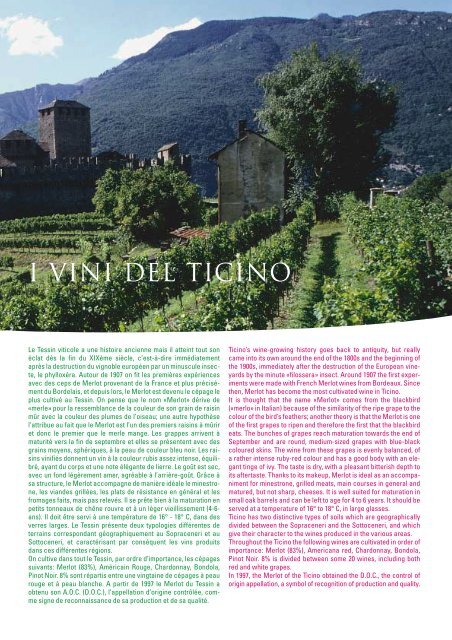TICINO GASTRONOMIA - Sonnenstube.com
TICINO GASTRONOMIA - Sonnenstube.com
TICINO GASTRONOMIA - Sonnenstube.com
Create successful ePaper yourself
Turn your PDF publications into a flip-book with our unique Google optimized e-Paper software.
I VINI DEL <strong>TICINO</strong><br />
Le Tessin viticole a une histoire ancienne mais il atteint tout son<br />
éclat dès la fin du XIXème siècle, c’est-à-dire immédiatement<br />
après la destruction du vignoble européen par un minuscule insecte,<br />
le phylloxéra. Autour de 1907 on fit les premières expériences<br />
avec des ceps de Merlot provenant de la France et plus précisément<br />
du Bordelais, et depuis lors, le Merlot est devenu le cépage le<br />
plus cultivé au Tessin. On pense que le nom «Merlot» dérive de<br />
«merle» pour la ressemblance de la couleur de son grain de raisin<br />
mûr avec la couleur des plumes de l’oiseau; une autre hypothèse<br />
l’attribue au fait que le Merlot est l’un des premiers raisins à mûrir<br />
et donc le premier que le merle mange. Les grappes arrivent à<br />
maturité vers la fin de septembre et elles se présentent avec des<br />
grains moyens, sphériques, à la peau de couleur bleu noir. Les raisins<br />
vinifiés donnent un vin à la couleur rubis assez intense, équilibré,<br />
ayant du corps et une note élégante de lierre. Le goût est sec,<br />
avec un fond légèrement amer, agréable à l’arrière-goût. Grâce à<br />
sa structure, le Merlot ac<strong>com</strong>pagne de manière idéale le minestrone,<br />
les viandes grillées, les plats de résistance en général et les<br />
fromages faits, mais pas relevés. Il se prête bien à la maturation en<br />
petits tonneaux de chêne rouvre et à un léger vieillissement (4-6ans).<br />
Il doit être servi à une température de 16° - 18° C, dans des<br />
verres larges. Le Tessin présente deux typologies différentes de<br />
terrains correspondant géographiquement au Sopraceneri et au<br />
Sottoceneri, et caractérisant par conséquent les vins produits<br />
dans ces différentes régions.<br />
On cultive dans tout le Tessin, par ordre d’importance, les cépages<br />
suivants: Merlot (83%), Américain Rouge, Chardonnay, Bondola,<br />
Pinot Noir. 8% sont répartis entre une vingtaine de cépages à peau<br />
rouge et à peau blanche. A partir de 1997 le Merlot du Tessin a<br />
obtenu son A.O.C. (D.O.C.), l’appellation d’origine contrôlée, <strong>com</strong>me<br />
signe de reconnaissance de sa production et de sa qualité.<br />
Ticino’s wine-growing history goes back to antiquity, but really<br />
came into its own around the end of the 1800s and the beginning of<br />
the 1900s, immediately after the destruction of the European vineyards<br />
by the minute «filossera» insect. Around 1907 the first experiments<br />
were made with French Merlot wines from Bordeaux. Since<br />
then, Merlot has be<strong>com</strong>e the most cultivated wine in Ticino.<br />
It is thought that the name «Merlot» <strong>com</strong>es from the blackbird<br />
(«merlo» in Italian) because of the similarity of the ripe grape to the<br />
colour of the bird’s feathers; another theory is that the Merlot is one<br />
of the first grapes to ripen and therefore the first that the blackbird<br />
eats. The bunches of grapes reach maturation towards the end of<br />
September and are round, medium-sized grapes with blue-black<br />
coloured skins. The wine from these grapes is evenly balanced, of<br />
a rather intense ruby-red colour and has a good body with an elegant<br />
tinge of ivy. The taste is dry, with a pleasant bitterish depth to<br />
its aftertaste. Thanks to its makeup, Merlot is ideal as an ac<strong>com</strong>paniment<br />
for minestrone, grilled meats, main courses in general and<br />
matured, but not sharp, cheeses. It is well suited for maturation in<br />
small oak barrels and can be left to age for 4 to 6 years. It should be<br />
served at a temperature of 16° to 18° C, in large glasses.<br />
Ticino has two distinctive types of soils which are geographically<br />
divided between the Sopraceneri and the Sottoceneri, and which<br />
give their character to the wines produced in the various areas.<br />
Throughout the Ticino the following wines are cultivated in order of<br />
importance: Merlot (83%), Americana red, Chardonnay, Bondola,<br />
Pinot Noir. 8% is divided between some 20 wines, including both<br />
red and white grapes.<br />
In 1997, the Merlot of the Ticino obtained the D.O.C., the control of<br />
origin appellation, a symbol of recognition of production and quality.


